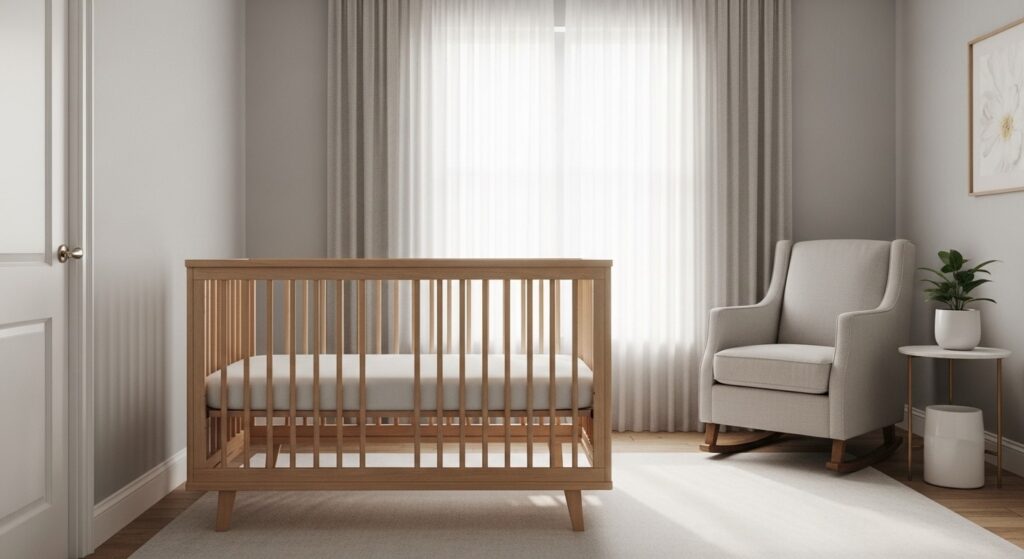Are Crib Bumper Pads Safe? The Evidence-Based Answer Parents Need
You’re carefully planning every detail of your baby’s nursery, wanting it to be a cozy, beautiful, and above all safe space.
As you browse stores or look at picture-perfect nurseries online, you repeatedly see cribs lined with soft, cushioned bumper pads. They seem like a standard part of a crib bedding set.
This leads to one of the most common points of confusion for new parents: are crib bumper pads safe?
You’re worried about your baby bumping their head or getting a tiny leg stuck between the slats, but you may have also heard vague warnings about them.
This article is here to give you a clear, unambiguous answer based on years of research from the world’s leading pediatric safety experts.
The short answer, right up front, is no, crib bumper pads are not safe. Here’s exactly why.
Why Do Parents Consider Crib Bumpers in the First Place?
It’s completely understandable why parents think bumpers are a good idea. The reasons are usually twofold:
- The Aesthetic Appeal: For decades, crib bumpers have been sold as part of matching “bed-in-a-bag” sets. They coordinate with sheets and blankets and are used heavily in nursery design photos, making them seem like a necessary decorative item.
- The Perceived Protection: The fear of your baby hitting their head on a wooden slat or getting a leg stuck is a powerful motivator. It feels intuitive to want to cushion those hard surfaces.
While these concerns come from a place of love and protection, the data shows that the solution is not a bumper pad. The risks they introduce are far greater than the minor problems they are meant to solve.
The Official Verdict: What Top Safety Experts Say
You don’t have to rely on opinions. The most respected child safety organizations in the United States have made their positions crystal clear.
The American Academy of Pediatrics (AAP) Recommendation
- A Clear “No-Go” for SIDS Prevention
The AAP’s safe sleep guidelines are the gold standard for preventing Sudden Infant Death Syndrome (SIDS) and other sleep-related infant deaths. Their recommendation is unequivocal: do not use crib bumpers. They state that there is no evidence that bumpers prevent serious injury, but there is clear evidence that they increase the risk of suffocation, strangulation, and entrapment.
The U.S. Consumer Product Safety Commission (CPSC)
- Data on Bumper-Related Infant Deaths
The CPSC, the federal agency responsible for protecting the public from unreasonable risks of injury or death associated with consumer products, has documented the dangers. Between 1990 and 2019, the CPSC reported 113 deaths linked to crib bumpers. These findings show that bumpers are not just theoretically risky; they have been directly implicated in infant fatalities.

The Dangers Explained: 3 Ways Crib Bumpers Introduce Risk
The warnings from experts are based on three primary, well-documented hazards:
- Suffocation Risk: This is the most serious risk. Newborns and young infants lack the motor skills and strength to move their heads if they roll into a position where their breathing is blocked. A baby’s face can press directly against a soft bumper, leading to suffocation.
- Strangulation Risk: The ties used to secure the bumper to the crib slats can come loose. These detached ties can become wrapped around a baby’s neck, posing a significant strangulation hazard.
- Climbing Aid: As your baby grows into a toddler, their mobility and curiosity increase. A firm bumper pad can act as a step, allowing them to climb up and potentially fall out of the crib, which can cause serious injury.
What About “Breathable” or “Mesh” Crib Liners?
This is one of the most common follow-up questions. In response to safety concerns, companies developed “breathable” mesh crib liners.
They are marketed as a safer alternative because they are thinner and allow air to pass through.
However, the AAP does not recommend mesh crib liners either. While they may reduce the direct risk of suffocation, they are not proven to prevent the types of injuries parents fear, and they still pose a risk of entrapment or strangulation if they are not installed perfectly or come loose. The safest crib is a bare crib.
The “Safe Sleep for Babies Act”: A Federal Ban
To underscore the severity of the risk, the U.S. government has taken action. In 2022, the Safe Sleep for Babies Act was signed into law.
This federal law makes it illegal to manufacture or sell non-fitted sheets and padded crib bumpers in the United States.
This decisive action was based on the overwhelming data linking these products to infant deaths.
If you see a padded bumper for sale—whether second-hand or from an old source—know that it is a banned product for a reason.
The Gold Standard: How to Create a Truly Safe Crib Environment
Now for the most important part: what you should do instead. Creating a safe sleep space is actually simpler than you think. The key is to follow the ABC’s of Safe Sleep.
- A – Alone: Your baby should always be alone in their sleep space. This means no bumpers, but also no blankets, pillows, stuffed animals, or other soft items.
- B – Back: Always place your baby on their back for every sleep, including naps.
- C – Crib: Your baby should sleep in a crib, bassinet, or play yard that meets current CPSC safety standards on a firm, flat mattress with only a fitted sheet.
That’s it. A firm mattress with a tight-fitting fitted sheet is all you need. Parents’ fears about head-bumping and stuck limbs are understandable, but these events rarely cause more than temporary, minor discomfort and are a normal part of a baby learning their physical boundaries.
FAQ: Quick Answers to Common Questions
- Q: Are vertical crib rail covers safe?
Unlike horizontal bumpers, vertical rail covers or wraps that cushion individual slats are not explicitly banned. However, the safest approach recommended by all experts is to leave the crib entirely bare. - Q: My baby keeps hitting their head. What should I do?
This is almost always a minor issue. A baby is not strong enough to hit their head on the slats with enough force to cause serious injury. It is much safer to let them occasionally bump their head than to add a hazardous bumper to the crib. - Q: Why are crib bumpers still available if they’re banned?
The ban targets manufacturing and sale within the U.S. You may still see them on second-hand marketplaces or from international sellers. Regardless of where you see them, avoid them. - Q: What if my baby rolls onto their stomach?
If your baby can roll over on their own, you do not need to reposition them onto their back. The key is to always place them on their back initially and ensure the sleep space is free of all soft items.
Conclusion: Your Confidence in a Safe Nursery
Creating the safest sleep environment for your baby means resisting the urge to add accessories to the crib. A bare crib is the safest crib.
By leaving out the bumper pads, you are not depriving your child of comfort or protection; you are following the evidence-based recommendations of pediatric experts and actively removing a known hazard from their nursery.
You can now move forward with confidence, knowing that the simplest choice is also the safest one.
Call-to-Action: Share this article with other new or expecting parents to help spread the word about safe sleep.

